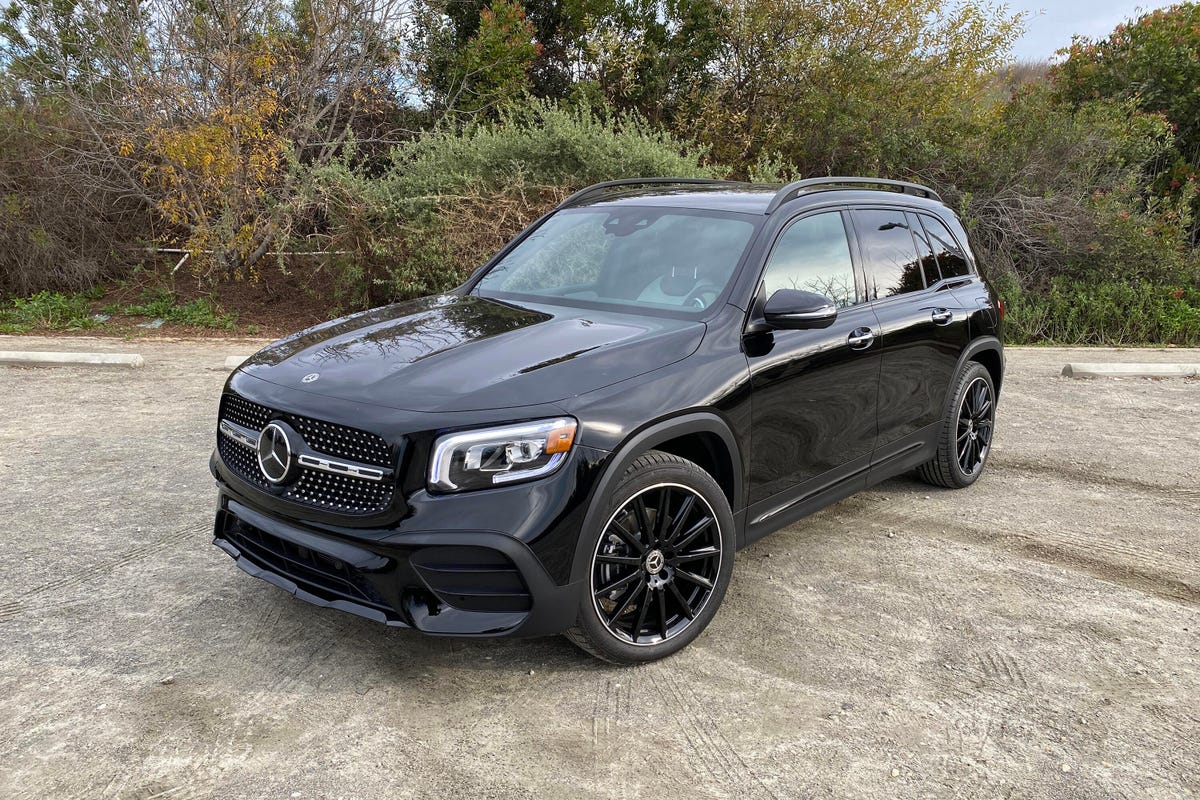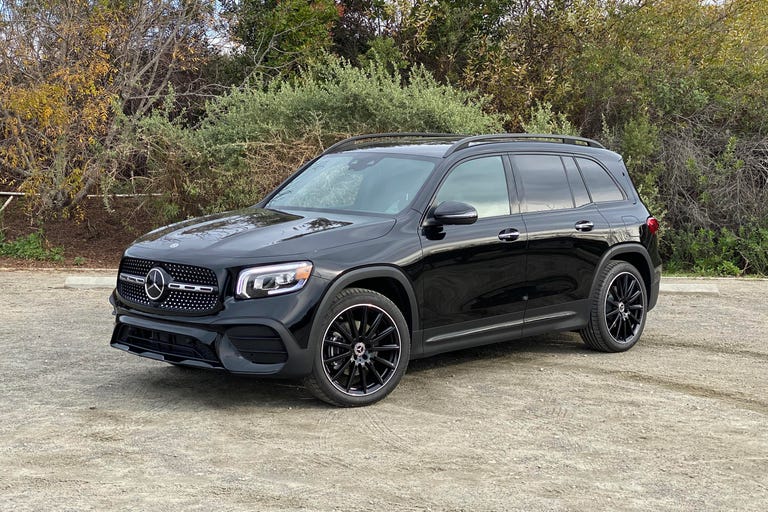 Why You Can Trust CNET
Why You Can Trust CNET 2020 Mercedes-Benz GLB250 review: Fitting in and standing out
Mercedes' new GLB-Class splits the difference between the GLA and GLC, and in a lot of ways, it's better than both.
The GLB250 looks properly sporty with its AMG Line styling option.
Launching a new SUV these days can often feel like splitting hairs. You might not have seen much white space between the subcompact Mercedes-Benz GLA-Class and the slightly larger-but-still-compact GLC-Class, yet that's exactly where this new GLB-Class SUV intends to exist. But rather than simply being a tweener, a sort of half-step between the GLA and GLC , the GLB has a number of attributes that help it stand out. In fact, given the choice between all three, the GLB is the one I'd want to park in my garage.
Like
- Boxy style is cute and functional
- Lots of head- and legroom
- MBUX infotainment tech is solid
Don't like
- Seven-seat option seems unnecessary
- Fuel economy isn't great
- Gets expensive when you pile on the options
Part of what helps the GLB stand out is its design. You can certainly see elements of Mercedes' other new SUVs here, specifically in the lower front fascia and the shape of the taillights. But instead of looking like a hodge-podge of the GLA and GLC -- or, god forbid, another freaking coupe-over -- the GLB actually sort of resembles Mercedes' older GLK-Class . It's boxy in all the right ways.
I also like how you can change the GLB's aesthetic depending on which options you choose. Stick with a smaller set of 18-inch wheels and the standard styling, and the GLB is a rugged little cute-ute. Go for 20-inch wheels and pick the AMG Line exterior like the car you see here, and the GLB almost looks like a grown-up hot hatch.
Dimensionally speaking, the GLB and GLC are extremely similar. The GLC is a little bit longer and a little bit wider, but the GLB is taller. It might not surprise you to learn that the GLB's squared-off edges allow for slightly more headroom and cargo space than the GLC, but interestingly, it offers more front and rear legroom, too. Of course, that's if you spec the GLB in its standard, five-passenger configuration. Yes, you can get the GLB with a third row of seats -- an $850 upcharge -- but I wouldn't recommend it. I've looked at the cargo area of my five-seat test car from every angle and I just can't imagine cramming a third row in there, especially since it'll impede on second-row legroom and cargo capacity. If you're planning to schlep a sizeable brood on the regular, you probably need a larger vehicle.
Increased headroom aside, the GLB's upright windshield, high seating position and low beltline do a lot to drive home the overall feeling of spaciousness. You can see all the way down the gradually sloping hood, and the relatively thin A-pillars don't hurt sight lines too much. Taller folks won't have issues getting comfortable up front or in back. Get the $1,500 panoramic sunroof for maximum wide-open effect.
A pair of 10.25-inch screens run Mercedes' excellent MBUX infotainment tech.
The GLB's big, two-screen infotainment setup sits below the base of the windshield, adding to that great outward visibility. A pair of 7-inch screens are standard, but the $2,250 Premium Package pumps those up to 10.25-inch displays, with crisp graphics and bright colors, and reconfigurable layouts and designs. This is the same MBUX multimedia interface you'll find in Mercedes' other new cars; the screens can be operated by touch, thumbpads on the steering wheel, a trackpad on the center console or through the company's natural-speech voice commands.
MBUX gets a thumbs-up for its standard inclusion of Apple CarPlay, Android Auto and a wireless hotspot, not to mention the super-cool augmented reality overlays that display on the forward-facing camera when you're in an active navigation route. On the other hand, I still find the voice-activated virtual assistant to be a little finicky. Sure, I can say, "Hey, Mercedes, I'm cold," and the car will automatically crank up the heat. But if I'm having a conversation with a passenger and I so much as mention the word "Mercedes," the system pipes up with, "How can I help you?" (Is there such a thing as AI tech being too helpful?)
The driver-assistance technology loadout is also impressive, though you have to pay to play. Mercedes' attention assist and brake assist are standard, as is the federally mandated backup camera, but every other driving aid is sadly locked behind the paywall. The $2,250 Driver Assistance Package gets you most of the things you really want, including adaptive cruise control, lane-keeping assist, blind-spot monitoring, lane-change assist, route-based speed adaptation and more. A further $1,090 Parking Assistance Package tacks on a surround-view camera and an active parking aid. All of these systems work as advertised, and nicely integrate into the behind-the-wheel experience. The lane-keeping system doesn't ping-pong you between white lines, and the adaptive cruise control smoothly raises and lowers the car's speed.
Everything about the GLB's on-road vibe is pretty easygoing. The chassis is nicely tuned to filter out harsh bumps in the road -- even on these big, 20-inch wheels -- but translates just enough feedback to the driver to let you know what's happening at road level. The steering is light, but quick to respond. You can switch between Comfort, Sport and Eco driving modes, though aside from some altered transmission shift points, I can't really feel much of a difference. There's an Individual setting, too, but you have to manually select it each time you start the car. (This annoyance isn't unique to the GLB, by the way. Why let me create my own setting but then force me to toggle the Drive Select dial up from Comfort to Sport to Individual every single time?)
Mercedes-Benz only offers its new SUV in GLB250 guise for now. Front-wheel drive is standard, but 4Matic all-wheel drive is available for $2,000. Get 4Matic and you also get an Off-Road drive setting, which reduces throttle response and keeps the anti-lock brakes from intervening too quickly. Hill-descent control is available, too, but let's be honest: the GLB250 is as much an off-roader as it is a seven-seater.
Under the hood, the GLB employs a 2.0-liter, turbocharged, four-cylinder engine, good for 221 horsepower and 258 pound-feet of torque. That's not a ton of power -- Mercedes-Benz estimates a 0-to-60-mph time of about 7 seconds -- but it's enough for zipping through the city and passing Priuses on the highway. The eight-speed, dual-clutch automatic transmission shifts quickly, but more importantly, smoothly.
As for fuel economy, the GLB is about on part with other subcompact SUVs. Regardless of drive configuration, you're looking at an EPA-estimated 26 miles per gallon combined. Interestingly, the all-wheel-drive version is 1-mpg more efficient on the highway cycle, at 31 mpg compared to the FWD's 30 mpg. Even so, during mixed driving, I tend to see numbers closer to the GLB's 23-mpg city rating.
It's worth noting that the similarly sized -- and more expensive -- GLC is objectively the better performer. Its turbocharged 2.0-liter engine makes 255 hp and 273 lb-ft of torque, and it'll accelerate to 60 mph in a quicker 6.1 seconds. Yes, the GLB250 is a little pokey by comparison, though it's every bit as quiet and refined as its bigger brother. Besides, if you need more oomph, there's always the upcoming Mercedes-AMG GLB35.
The GLB250 is arguably the most compelling of Mercedes' compact SUVs.
On the other side of the spectrum, the smaller GLA-Class offers a less-expensive alternative, though if you're going to go that route, at least wait for the vastly improved new version to go on sale. Still, I think the GLB is the right size with the right features at the right price. Whether you're comparing it to the GLA or GLC, the GLB250 offers the same luxury and tech with more interior space and, frankly, more personality.
At $37,595, the GLB250 undercuts the base price of a GLC300 by $5,900. But like any modern Mercedes, the price climbs quickly from there. Go wild with the upgrades and you can spec a GLB250 4Matic up to roughly $60,000. Exercise a little restraint, however, and you can drive away in a modestly optioned version like my test car for around $47,000. That's certainly not chump change, but it's an easier pill to swallow than a similarly equipped GLC300. A BMW X1 costs about the same, too, and the Bimmer isn't nearly as spacious -- or as attractive.
What I like best about the GLB-Class is that it doesn't just split the difference between the GLA and GLC. Trying to wedge itself between those two vehicles could've resulted in a mediocre half-step -- not different enough from the GLA to warrant a price hike, but too compromised to be a compelling alternative to a GLC. Instead, the GLB can proudly stand on its own, with style and substance in spades.



